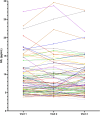Longitudinal evaluation of serum neurofilament light levels in normal healthy volunteers: defining a threshold of concern
- PMID: 40665000
- PMCID: PMC12263756
- DOI: 10.1007/s00415-025-13246-2
Longitudinal evaluation of serum neurofilament light levels in normal healthy volunteers: defining a threshold of concern
Abstract
Neurofilament light (NfL) is a neuron-specific protein integral to neuronal cytoskeletons. Upon damage to the central or peripheral nervous system (NS), NfL is released into cerebrospinal fluid and blood. Elevated serum or plasma NfL levels have been reported in a variety of diseases and NS injury states. However, although intraindividual longitudinal NfL changes may be more meaningful than NfL measurements at a single timepoint, data on the longitudinal variation of NfL in normal healthy volunteers (NHV) are scarce. We investigated normal variation in NHV serum NfL and estimate an upper limit of normal (ULN) of NfL variation in longitudinal samples. An initial cross-sectional screening in sera from 270 NHV using a 4-plex assay detected NfL in 99.6% and glial fibrillary acidic protein (GFAP) in 100%, while Tau (67.4%), and Ubiquitin Carboxyl-Terminal Hydrolase L1 (UCH-L1, 4.1%) were less frequently detectable. An age-dependent increase was found in NfL (2.36% per year) and GFAP (1.18% per year). Longitudinal evaluation of NfL was then conducted in a separate cohort of 80 NHV at baseline, day 14 (range 11-17), and day 28 (range 26-56). A 1.64-fold increase from baseline in serum NfL was calculated as the ULN. Putting this threshold into context with published reports on NfL across a large variety of injury and disease settings, the 1.64-fold threshold is well positioned to discriminate between healthy and NS injury. Altogether, these findings provide a framework for longitudinal monitoring of serum NfL as a biomarker for neuronal damage in multiple contexts of use, including drug-induced injury.
Keywords: Biomarker; GFAP; Neurofilament light chain; NfL; Tau; UCH-L1.
© 2025. The Author(s).
Conflict of interest statement
Declarations. Conflicts of interest: TAL, CJS, KAF, SAP, and SKR were employees of Pfizer Inc., KV was an employee of Merck Sharp & Dohme LLC, a subsidiary of Merck & Co., Inc., FT was an employee of Johnson & Johnson, and TK-T was an employee of Roche Pharma at the time this work was performed. KR received research support from Novartis, Merck Serono, German Ministry of Education and Research, European Union (821283–2), Stiftung Charité, Guthy-Jackson Charitable Foundation and Arthur Arnstein Foundation; received travel grants from Guthy-Jackson Charitable Foundation; received speaker’s honoraria from Virion Serion and Novartis; was a participant in the BIH Clinical Fellow Program funded by Stiftung Charité. This project has received funding from the Innovative Medicines Initiative 2 Joint Undertaking under grant agreement No 821283. This Joint Undertaking receives support from the European Union’s Horizon 2020 research and innovation program and EFPIA companies.
Figures





Similar articles
-
Effects of Selective Head-and-Neck Cooling on Brain Injury-Related Biomarker Levels and Symptom Rating Following a Boxing Bout: Protocol for an Exploratory Randomized Trial.JMIR Res Protoc. 2025 Jun 16;14:e68954. doi: 10.2196/68954. JMIR Res Protoc. 2025. PMID: 40523276 Free PMC article.
-
Association of Blood-Based Biomarkers and 6-Month Patient-Reported Outcomes in Patients With Mild TBI: A CENTER-TBI Analysis.Neurology. 2025 Jan 14;104(1):e210040. doi: 10.1212/WNL.0000000000210040. Epub 2024 Dec 9. Neurology. 2025. PMID: 39652812 Free PMC article.
-
The impact of kidney function on Alzheimer's disease blood biomarkers: implications for predicting amyloid-β positivity.Alzheimers Res Ther. 2025 Feb 19;17(1):48. doi: 10.1186/s13195-025-01692-z. Alzheimers Res Ther. 2025. PMID: 39972340 Free PMC article.
-
Prognostic Value of Blood-Based Protein Biomarkers in Traumatic Brain Injury: A Living Systematic Review and Meta-Analysis.J Neurotrauma. 2025 Aug;42(15-16):1256-1286. doi: 10.1089/neu.2024.0620. Epub 2025 May 27. J Neurotrauma. 2025. PMID: 40432557 Review.
-
The Diagnostic and Prognostic Role of Biomarkers in Mild Traumatic Brain Injury: An Umbrella Meta-Analysis.Brain Sci. 2025 May 28;15(6):581. doi: 10.3390/brainsci15060581. Brain Sci. 2025. PMID: 40563753 Free PMC article. Review.
References
-
- Ashrafzadeh-Kian S, Figdore D, Larson B, Deters R, Abou-Diwan C, Bornhorst J, Algeciras-Schimnich A (2024) Head-to-head comparison of four plasma neurofilament light chain (NfL) immunoassays. Clin Chim Acta 561:119817 - PubMed
-
- Bazarian JJ, Biberthaler P, Welch RD, Lewis LM, Barzo P, Bogner-Flatz V, Gunnar Brolinson P, Buki A, Chen JY, Christenson RH, Hack D, Huff JS, Johar S, Jordan JD, Leidel BA, Lindner T, Ludington E, Okonkwo DO, Ornato J, Peacock WF, Schmidt K, Tyndall JA, Vossough A, Jagoda AS (2018) Serum GFAP and UCH-L1 for prediction of absence of intracranial injuries on head CT (ALERT-TBI): a multicentre observational study. Lancet Neurol 17:782–789 - PubMed
-
- Benkert P, Meier S, Schaedelin S, Manouchehrinia A, Yaldizli O, Maceski A, Oechtering J, Achtnichts L, Conen D, Derfuss T, Lalive PH, Mueller C, Muller S, Naegelin Y, Oksenberg JR, Pot C, Salmen A, Willemse E, Kockum I, Blennow K, Zetterberg H, Gobbi C, Kappos L, Wiendl H, Berger K, Sormani MP, Granziera C, Piehl F, Leppert D, Kuhle J (2022) Serum neurofilament light chain for individual prognostication of disease activity in people with multiple sclerosis: a retrospective modelling and validation study. Lancet Neurol 21(1):246–257 - PubMed
MeSH terms
Substances
Grants and funding
LinkOut - more resources
Full Text Sources
Miscellaneous

